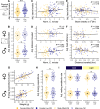The keystone gut species Christensenella minuta boosts gut microbial biomass and voluntary physical activity in mice
- PMID: 38132571
- PMCID: PMC10865807
- DOI: 10.1128/mbio.02836-23
The keystone gut species Christensenella minuta boosts gut microbial biomass and voluntary physical activity in mice
Abstract
The gut bacteria of the family Christensenellaceae are consistently associated with metabolic health, but their role in promoting host health is not fully understood. Here, we explored the effect of Christensenella minuta amendment on voluntary physical activity and the gut microbiome. We inoculated male and female germ-free mice with an obese human donor microbiota together with live or heat-killed C. minuta for 28 days and measured physical activity in respirometry cages. Compared to heat-killed, the live-C. minuta treatment resulted in reduced feed efficiency and higher levels of physical activity, with significantly greater distance traveled for males and higher levels of small movements and resting metabolic rate in females. Sex-specific effects of C. minuta treatment may be in part attributable to different housing conditions for males and females. Amendment with live C. minuta boosted gut microbial biomass in both sexes, immobilizing dietary carbon in the microbiome, and mice with high levels of C. minuta lose more energy in stool. Live C. minuta also reduced within and between-host gut microbial diversity. Overall, our results showed that C. minuta acts as a keystone species: despite low relative abundance, it has a large impact on its ecosystem, from the microbiome to host energy homeostasis.IMPORTANCEThe composition of the human gut microbiome is associated with human health. Within the human gut microbiome, the relative abundance of the bacterial family Christensenellaceae has been shown to correlate with metabolic health and a lean body type. The mechanisms underpinning this effect remain unclear. Here, we show that live C. minuta influences host physical activity and metabolic energy expenditure, accompanied by changes in murine metabolism and the gut microbial community in a sex-dependent manner in comparison to heat-killed C. minuta. Importantly, live C. minuta boosts the biomass of the microbiome in the gut, and a higher level of C. minuta is associated with greater loss of energy in stool. These observations indicate that modulation of activity levels and changes to the microbiome are ways in which the Christensenellaceae can influence host energy homeostasis and health.
Keywords: Christensenella; energy; microbiome.
Conflict of interest statement
The authors declare no conflict of interest.
Figures




Similar articles
-
Human genetics shape the gut microbiome.Cell. 2014 Nov 6;159(4):789-99. doi: 10.1016/j.cell.2014.09.053. Cell. 2014. PMID: 25417156 Free PMC article.
-
Syntrophy via Interspecies H2 Transfer between Christensenella and Methanobrevibacter Underlies Their Global Cooccurrence in the Human Gut.mBio. 2020 Feb 4;11(1):e03235-19. doi: 10.1128/mBio.03235-19. mBio. 2020. PMID: 32019803 Free PMC article.
-
A New Strain of Christensenella minuta as a Potential Biotherapy for Obesity and Associated Metabolic Diseases.Cells. 2021 Apr 6;10(4):823. doi: 10.3390/cells10040823. Cells. 2021. PMID: 33917566 Free PMC article.
-
A Keystone Gut Bacterium Christensenella minuta-A Potential Biotherapeutic Agent for Obesity and Associated Metabolic Diseases.Foods. 2023 Jun 26;12(13):2485. doi: 10.3390/foods12132485. Foods. 2023. PMID: 37444223 Free PMC article. Review.
-
Christensenella minuta, a new candidate next-generation probiotic: current evidence and future trajectories.Front Microbiol. 2024 Jan 11;14:1241259. doi: 10.3389/fmicb.2023.1241259. eCollection 2023. Front Microbiol. 2024. PMID: 38274765 Free PMC article. Review.
Cited by
-
Christensenella minuta interacts with multiple gut bacteria.Front Microbiol. 2024 Feb 19;15:1301073. doi: 10.3389/fmicb.2024.1301073. eCollection 2024. Front Microbiol. 2024. PMID: 38440147 Free PMC article.
-
Development of Next Generation Probiotics for Cardiometabolic Diseases.Phenomics. 2025 Mar 21;5(1):18-22. doi: 10.1007/s43657-025-00230-z. eCollection 2025 Feb. Phenomics. 2025. PMID: 40313602 Free PMC article. No abstract available.
-
The microbiome's influence on obesity: mechanisms and therapeutic potential.Sci China Life Sci. 2025 Mar;68(3):657-672. doi: 10.1007/s11427-024-2759-3. Epub 2024 Nov 28. Sci China Life Sci. 2025. PMID: 39617855 Review.
-
Genomic and functional co-diversification imprint African Hominidae microbiomes to signal dietary and lifestyle adaptations.Gut Microbes. 2025 Dec;17(1):2484385. doi: 10.1080/19490976.2025.2484385. Epub 2025 Mar 31. Gut Microbes. 2025. PMID: 40164980 Free PMC article.
-
Clinical translation of microbiome research.Nat Med. 2025 Apr;31(4):1099-1113. doi: 10.1038/s41591-025-03615-9. Epub 2025 Apr 11. Nat Med. 2025. PMID: 40217076 Review.
References
-
- Suzuki TA, Fitzstevens JL, Schmidt VT, Enav H, Huus KE, Mbong Ngwese M, Grießhammer A, Pfleiderer A, Adegbite BR, Zinsou JF, Esen M, Velavan TP, Adegnika AA, Song LH, Spector TD, Muehlbauer AL, Marchi N, Kang H, Maier L, Blekhman R, Ségurel L, Ko G, Youngblut ND, Kremsner P, Ley RE. 2022. Codiversification of gut microbiota with humans. Science 377:1328–1332. doi:10.1126/science.abm7759 - DOI - PMC - PubMed
-
- Yatsunenko T, Rey FE, Manary MJ, Trehan I, Dominguez-Bello MG, Contreras M, Magris M, Hidalgo G, Baldassano RN, Anokhin AP, Heath AC, Warner B, Reeder J, Kuczynski J, Caporaso JG, Lozupone CA, Lauber C, Clemente JC, Knights D, Knight R, Gordon JI. 2012. Human gut microbiome viewed across age and geography. Nature 486:222–227. doi:10.1038/nature11053 - DOI - PMC - PubMed
MeSH terms
Supplementary concepts
Grants and funding
LinkOut - more resources
Full Text Sources
Molecular Biology Databases
